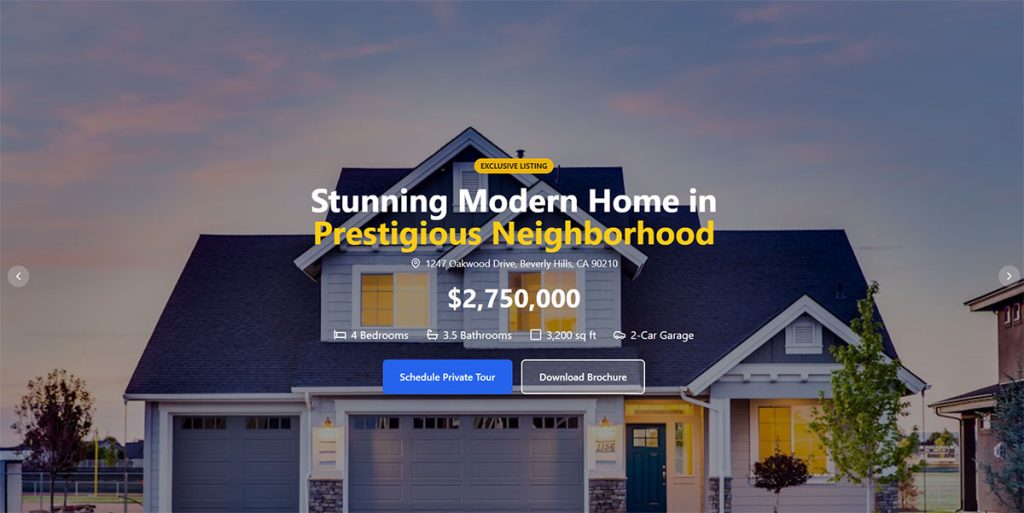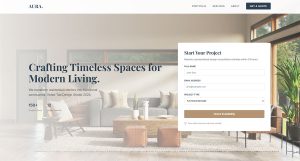Your model homes look stunning. Your craftsmanship speaks for itself. But none of that matters if qualified buyers never find you. Lead generation for home builders has shifted almost entirely…
Table of Contents
Real estate agents who master lead generation for real estate consistently outperform competitors by 300%. The difference between top producers and struggling agents lies in systematic prospect capture and nurturing strategies.
Modern property buyers start their home buying process online, visiting Multiple Listing Service websites and real estate platforms before contacting agents. Smart agents intercept these prospects through optimized property search functionality and strategic lead capture forms.
This comprehensive guide reveals proven techniques for generating buyer leads and seller leads across digital and traditional marketing channels. You’ll discover how real estate websites, social media platforms, and Customer Relationship Management systems work together to create consistent prospect flow.
Key areas covered include:
- Building conversion-focused real estate websites with IDX integration
- Social media lead generation through Facebook ads and Instagram marketing
- Email marketing automation for property lead nurturing
- Traditional marketing methods that still generate quality prospects
- CRM systems for managing real estate pipelines effectively
Master these lead generation strategies to build a predictable real estate business that thrives in any market condition.
Building Your Online Lead Capture System
Real Estate Website Optimization
Your real estate website serves as the foundation for capturing property leads. Modern home buyers expect seamless functionality when searching for their next property investment.
Property Search Functionality
Property search tools drive buyer engagement. Advanced filtering options help prospects narrow down listings by price range, location, and property features. IDX integration connects your site directly to the Multiple Listing Service, ensuring fresh inventory appears automatically.
Home Valuation Tools

Automated valuation models attract seller leads instantly. Property owners regularly check their home’s estimated value online. Smart agents capture these opportunities through well-designed valuation lead capture forms that require minimal information while delivering maximum value.
Contact Forms and Call-to-Action Buttons
Strategic placement of contact forms throughout your site increases conversion rates. Property listing pages need inquiry buttons. Market report downloads require email capture. Consultation requests should appear prominently on every page.
Effective form design balances information gathering with user experience. Too many fields discourage submissions. Too few fields produce unqualified prospects.
Mobile-Friendly Design Requirements
Real estate searches happen everywhere. Mobile forms must load quickly and function flawlessly on small screens. Property photos need crisp display across devices. Navigation should remain intuitive whether prospects browse on phones or tablets.
Landing Pages That Convert
Targeted landing pages capture specific buyer segments more effectively than generic websites.
Property-Specific Landing Pages
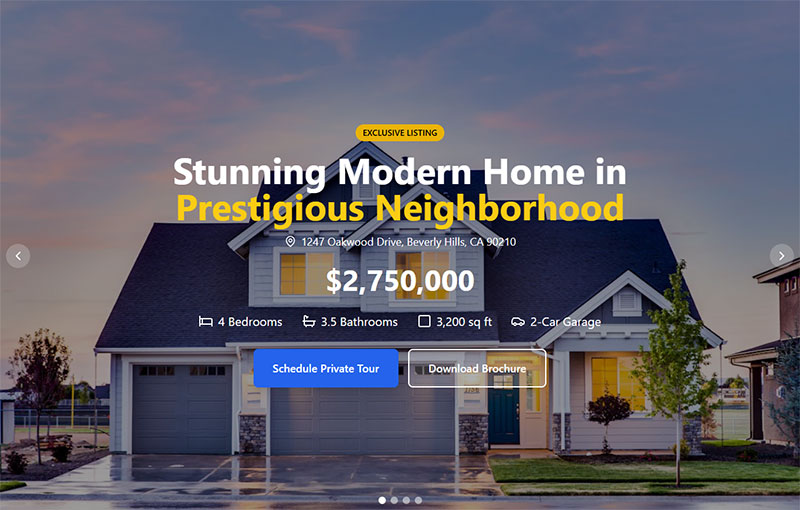
Individual property pages showcase homes with compelling descriptions and professional photography. Virtual tours keep visitors engaged longer. Neighborhood information adds context that helps buyers visualize their future lifestyle.
Neighborhood and Market Report Pages
Local market data attracts serious buyers and sellers. Quarterly price trends, inventory levels, and sales statistics demonstrate your market expertise. These resources position you as the area’s real estate authority.
First-Time Buyer Resource Pages
New buyers need education and guidance throughout their home buying process. Mortgage pre-approval checklists, inspection timelines, and closing cost calculators provide genuine value while capturing contact information.
Seller Consultation Request Pages
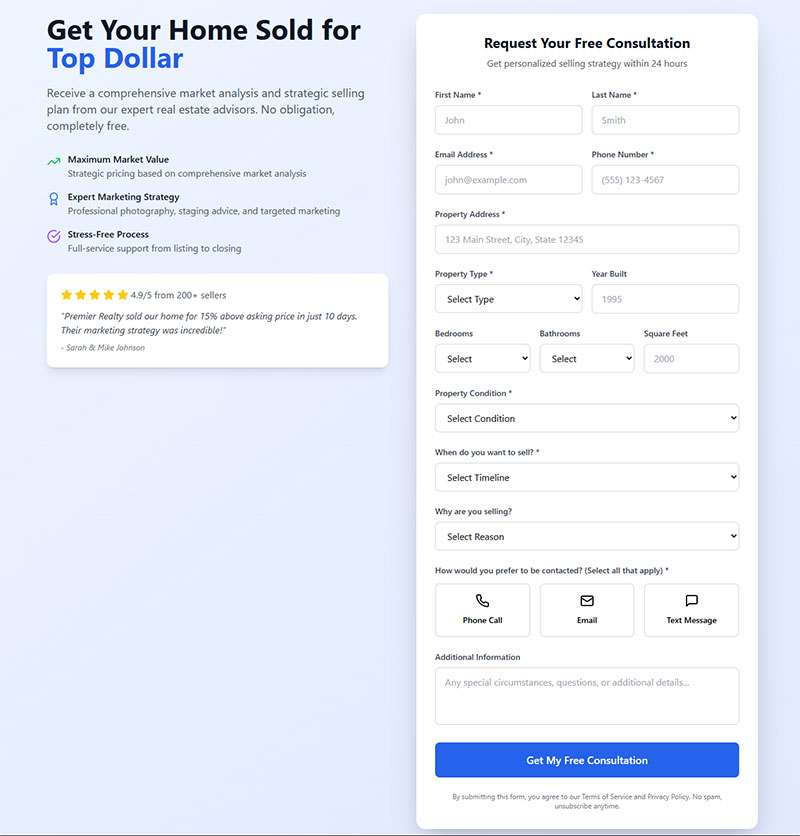
Motivated sellers seek professional guidance for pricing and marketing their homes. Consultation request forms should gather property details, timeline preferences, and contact preferences. Landing page forms perform better when they match the page’s specific purpose.
Lead Magnets and Content Offers
Valuable content exchanges build your prospect database while establishing trust and expertise.
Market Reports and Price Trends
Monthly market analysis reports attract both buyers and sellers. Include average days on market, price per square foot data, and inventory statistics. These reports demonstrate deep local knowledge while generating qualified leads.
Home Buying and Selling Guides
Comprehensive guides address common questions and concerns throughout real estate transactions.
Step-by-step processes reduce anxiety while positioning you as the helpful expert. Multi-step forms work well for detailed guide downloads.
Mortgage Calculator Tools
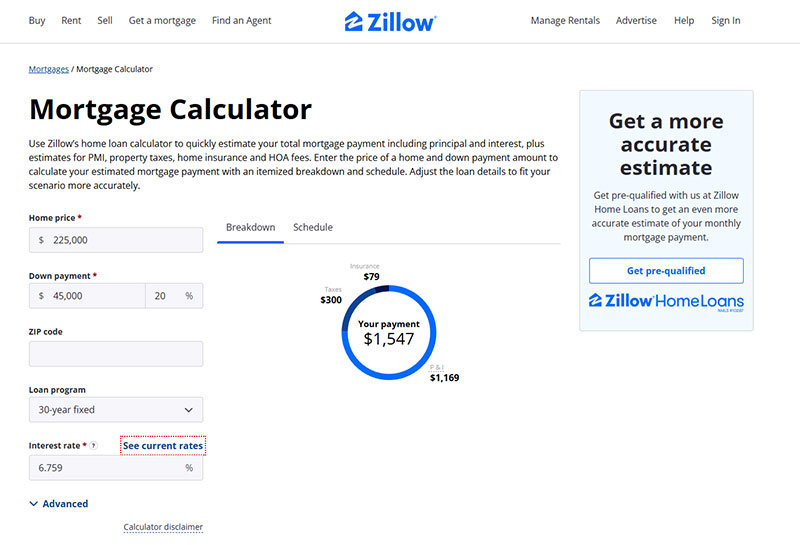
Interactive calculators engage prospects while collecting valuable qualification data.
Payment estimators, affordability calculators, and refinancing tools serve different audience segments. Each tool should capture contact information for follow-up.
Neighborhood Lifestyle Guides
Community information helps relocating families understand local amenities, school districts, and recreational opportunities.
Restaurant recommendations, shopping centers, and entertainment venues paint complete lifestyle pictures that influence buying decisions.
Social Media Lead Generation Strategies
Social media platforms offer powerful targeting capabilities for reaching potential real estate clients. 67% of real estate marketers plan to increase their social media marketing budgets in 2024, making this the right time to leverage these channels.
46% of realtors consider social media the best source of high-quality leads, outperforming traditional MLS systems. Even more compelling, 52% of leads from social media are of better quality than MLS leads (26%).
Facebook Marketing for Real Estate
Facebook’s robust advertising platform connects agents with highly targeted audiences based on demographics, interests, and behaviors. 90% of realtors use Facebook, making it the most popular platform in the industry.
Targeted Property Ads
Property showcase ads reach prospects actively searching for homes in specific price ranges and locations. Facebook ads for real estate have an average click-through rate of 1.59%. Facebook’s detailed targeting includes life events like “recently engaged” or “new job” that often precede home purchases.
Lead Generation Forms
Facebook’s native lead generation forms pre-populate user information, reducing friction while maintaining data quality. These forms integrate seamlessly with Customer Relationship Management systems for immediate follow-up.
Research shows that contact rates for leads that provide phone numbers are 4-5x higher than for leads that provide email addresses. While email leads might cost $2-3, phone leads convert significantly better despite higher costs.
Community Group Participation
Local Facebook groups provide networking opportunities with potential clients. Share market insights, answer housing questions, and establish yourself as the neighborhood real estate resource. Avoid direct sales pitches in favor of helpful information.
57% of Realtors believe social media helps maintain client relationships, making community engagement a valuable long-term strategy.
Facebook Marketplace Listings
Property listings on Facebook Marketplace reach different audiences than traditional real estate websites. Rental properties, investment opportunities, and unique homes often perform well on this platform.
Instagram and Visual Content Marketing
Instagram’s visual nature perfectly suits real estate marketing, where property photos drive engagement and inquiries. 62% of real estate agents use Instagram, with strong growth potential ahead.
Property Showcase Posts
High-quality property photos generate significant engagement on Instagram. Instagram posts with at least one hashtag receive 12.6% more engagement than those without. Behind-the-scenes content from listing appointments, staging processes, and closing celebrations humanizes your brand while maintaining professional credibility.
Professional photography makes a dramatic difference. Homes marketed with professionally edited photos see a 1,200% increase in social media shares and receive 47% higher asking prices per square foot.
Behind-the-Scenes Content
Day-in-the-life content builds personal connections with potential clients. Market research activities, client meetings, and continuing education demonstrate professionalism and expertise.
Strong engagement rates typically exceed 1% on average, with rates above 3-6% considered exceptional for real estate content.
Client Success Stories
Happy buyer and seller testimonials provide social proof that influences prospect decisions. Video testimonials perform particularly well, showing genuine emotion and satisfaction with your services.
Video content generates 1,200% more shares than text and image content combined, making testimonial videos especially valuable.
Local Area Highlights
Community spotlights showcase neighborhood amenities, local businesses, and seasonal events. This content attracts people considering relocation while positioning you as the local market expert.
LinkedIn for Professional Networking
LinkedIn targets professional audiences who often represent higher-value real estate prospects. 48% of real estate agents use LinkedIn for business development.
Industry Connections and Referrals
Professional networking generates quality referrals from mortgage lenders, attorneys, contractors, and other real estate service providers. These relationships often produce pre-qualified prospects.
LinkedIn ads targeting real estate professionals have an average conversion rate of 2.74%, significantly higher than other platforms.
Content Sharing and Thought Leadership
Regular market commentary and industry analysis establishes expertise while keeping your name visible to professional contacts. Share insights about regulatory changes, market trends, and investment opportunities.
94% of educators engage in professional discussions on LinkedIn, indicating high engagement potential for thought leadership content.
Business Development Opportunities
LinkedIn provides access to corporate relocation managers, human resources professionals, and business owners who influence employee relocations. These connections can generate significant referral volume.
Commercial Real Estate Prospects
Business owners and investors actively use LinkedIn for professional networking. Commercial property opportunities, investment property analysis, and market data appeal to this audience segment.
Key Performance Benchmarks
Understanding conversion rates helps set realistic expectations:
- The National Association of Realtors reports average conversion rates between 0.4%-1.2%
- Most real estate professionals report customer conversion rates of 3-5% in their specific markets
- 71% of buyers interviewed only one agent, and 81% of sellers worked with the first agent they contacted
This data emphasizes the importance of quick response times and strong first impressions.
Critical Success Factors
Follow-Up Systems
Only 25% of agents make a 2nd follow-up call, and fewer than one in ten agents make three or more follow-up calls. Even worse, 48% of real estate agents don’t follow up after their first call.
Video Content Priority
Listings with video get 49% more qualified leads and 73% of homeowners prefer to list with agents who use video. Video content should be a cornerstone of your social media strategy.
Client Preference Data
71% of buyers choose agents with a strong social media presence, making your online presence directly connected to business success.
Budget Allocation Insights
Smart agents invest strategically in social media marketing:
- 54.2% of real estate agents’ marketing budgets are allocated to digital marketing in 2024
- More than 50% of real estate agents earning $100,000 or more spent over $2,500 on technology
- Most U.S. real estate agents spend between $100 and $499 monthly on digital marketing
Real estate lead generation requires consistent effort across multiple channels. Online systems capture prospects efficiently while social media platforms expand your reach to targeted audiences. Success depends on providing genuine value while strategically collecting contact information for ongoing relationship building.
Traditional Marketing Channels That Still Work
Direct Mail Campaigns
Physical mail cuts through digital noise. Property owners still respond to well-designed postcards and letters about local real estate activity.
Direct mail has an average response rate of 3.63%, while digital ads achieve only 0.12%. 84% of consumers say they are more likely to open direct mail if it’s personalized, making targeted messaging crucial for success.
Just Listed and Just Sold Postcards
Neighborhood announcements generate seller leads and buyer inquiries. Recent sales data proves market activity while showcasing your success. Include professional property photos and clear contact information.
Real estate agents can expect 1% to 5% response rates depending on market competitiveness. Personalized direct mail generates a 6.5% response rate, compared to 2% for non-personalized pieces.
Market Update Mailers
Quarterly market reports position you as the local real estate authority. Price trends, inventory levels, and sales statistics provide valuable information homeowners want. These mailings generate consultation requests from potential sellers.
71% of people read direct mail the day it is delivered. 70% of respondents read direct mail pieces on the same day they receive them, and 69% share direct mail pieces with friends and family.
Targeted Neighborhood Campaigns
Geographic farming builds name recognition in specific areas. Consistent monthly mailings to 200-500 homes create top-of-mind awareness when residents consider buying or selling.
Direct mail has a higher open rate of 80-90%, compared to email’s 20-30%. An ideal farm includes 250 to 500 homes in areas with healthy real estate demand.
Seasonal Market Reports
Spring buying season, holiday market slowdowns, and year-end tax considerations provide timely content for direct mail campaigns. Seasonal relevance increases response rates significantly.
Direct mail is kept in a recipient’s home for an average of 17 days, providing extended exposure compared to digital marketing.
Open House Lead Capture
Open houses attract both serious buyers and curious neighbors. Smart lead capture systems maximize every visitor interaction.
About 53% of prospective homebuyers in the U.S. attend an open house during their home search. However, only 3% of homebuyers actually purchase homes they discover through open houses.
Visitor Registration Systems
Digital registration forms streamline the sign-in process while capturing essential contact information. Tablets or smartphones replace traditional paper guest books for better data collection.
71% of buyers interviewed only one agent, and 81% of sellers worked with the first agent they contacted. This makes first impressions at open houses critical for conversion success.
Follow-up Conversation Techniques
Strategic questioning reveals buyer motivation, timeline, and qualification status. Ask about their current housing situation, desired move date, and property preferences.
Approximately 0.4% to 2.4% of real estate leads convert into sales. For every 1,000 leads generated, only 4 to 24 result in closed deals.
Information Packet Distribution
Professional brochures with neighborhood statistics, mortgage information, and your contact details reinforce your expertise. Include feedback forms to gather visitor opinions about the property.
Agents spend an average of $0 to $250 monthly on lead generation, making open houses a cost-effective strategy when executed properly.
Contact Information Collection Methods
QR codes linking to property information requests capture contact data from smartphone users. Text message campaigns provide instant property details while building your prospect database.
Referral Program Development
Past clients and professional networks generate high-quality leads through systematic referral programs.
Up to 82% of real estate sales for agents with developed businesses come from previous clients, friends, and referrals. 38% of sellers who used a real estate agent found their agents through referrals by friends or family.
Past Client Referral Incentives
Satisfied customers become your best marketing channel. Gift cards, service credits, or charitable donations reward successful referrals while maintaining relationships with previous clients.
The typical real estate referral fee is 25% of the gross commission. The conversion rate is 30% higher from referred customers than from different lead sources.
Professional Network Partnerships
Mortgage lenders, attorneys, contractors, and home inspectors regularly encounter people planning real estate transactions. Formal referral agreements create mutual benefit opportunities.
Referral-driven purchases have a 30% higher average order value than purchases from non-referred customers. Referred customers have a 37% higher retention rate than those acquired through other methods.
Vendor and Service Provider Relationships
Moving companies, home improvement contractors, and utility services interact with relocating families. These partnerships often produce pre-qualified prospects.
The global average referral rate sits at 2.35%. For every 100 sales, about 2 come from referrals, but top performers achieve much higher rates.
Community Involvement Benefits
Chamber of Commerce membership, charity participation, and local event sponsorship build relationships that generate referrals. Community visibility establishes trust and credibility.
72% of sellers would definitely use the same agent again, indicating strong potential for repeat business and referrals when service quality is high.
Key Implementation Tips
Budget Allocation Strategy
Direct mail receives the highest ROI of 112% across all mediums, followed by SMS (102%), email (93%), and paid search (88%). Allocate your marketing budget accordingly.
Timing and Frequency
Coordinating digital and direct mail increased the response rate by 63%, website visits by 68%, and leads by 53%. Use multi-channel approaches for maximum impact.
Success Measurement
The conversion rate for referral marketing in real estate is 1.3%, while organic search achieves 3.2%. Track these metrics to optimize your traditional marketing investments.
97% of organizations that engage in direct mail campaigns have reported steady performance, making these traditional channels reliable foundations for long-term business growth.
Email Marketing and Lead Nurturing
Email List Building Strategies
Strategic email collection creates valuable prospect databases for ongoing relationship building. Email marketing generates $42 for every $1 spent, making it one of the highest-ROI marketing channels available today.
Newsletter Signup Incentives
Market reports, buying guides, and exclusive property alerts encourage subscription forms completion. Valuable content exchanges build trust while capturing contact information. Welcome emails achieve an impressive 83.63% open rate, significantly higher than regular campaigns.
Property-specific incentives perform exceptionally well in real estate. 54% of professionals use email to nurture long-term relationships, recognizing its power for sustained engagement.
Property Alert Subscriptions
Automated property notifications keep buyers engaged between active search periods. Geographic preferences, price ranges, and property features enable precise targeting.
Real estate businesses see a 37.18% average email open rate, outperforming many other industries. Personalized property alerts drive consistent engagement throughout extended buying cycles.
Market Update Notifications
Monthly market analysis reports attract both buyers and sellers interested in local real estate trends. Professional insights demonstrate expertise while maintaining regular contact.
The real estate industry averages a 3.6% click-through rate, ranking among the top-performing sectors for email engagement. Regular market updates position agents as trusted advisors.
Event Invitation Lists
First-time buyer seminars, market update presentations, and client appreciation events provide natural opportunities for email collection through WordPress event registration forms.
Automated Email Sequences
Systematic follow-up nurtures leads through extended sales cycles while reducing manual effort. 48% of marketers plan to include email automation in their programs, recognizing its efficiency advantages.
Welcome Series for New Subscribers
Multi-message sequences introduce your services, share testimonials, and provide market education. Automated welcome campaigns establish immediate value while building relationships.
Triggered emails achieve a 35.64% open rate with a 2.02% click-through rate, significantly outperforming standard campaigns. Welcome sequences specifically see 24.46% click-through rates, making them essential for new subscriber engagement.
Property Search Assistance Emails
Buyer education sequences explain the home buying process, mortgage pre-approval steps, and inspection procedures. Educational content builds trust while positioning you as the helpful expert.
Content marketing generates 3x more leads than traditional marketing while costing 62% less. Educational email sequences demonstrate expertise while nurturing prospects through complex buying decisions.
Market Education Campaigns
Regular market commentary keeps subscribers informed about pricing trends, inventory changes, and regulatory updates. Consistent valuable content maintains engagement between active transactions.
Email marketing converts 40% better than social media for lead generation. Regular market insights create ongoing touchpoints that social platforms cannot match.
Seasonal Real Estate Tips
Home maintenance advice, market timing considerations, and tax implications provide timely value throughout the year. Seasonal relevance increases open rates and engagement.
Personalized Follow-up Communications
Targeted messaging based on prospect behavior and preferences improves conversion rates significantly. Segmented email campaigns show 50% higher click-through rates than untargeted campaigns.
Property Match Notifications
Automated alerts when new listings meet buyer criteria maintain engagement during extended search periods. Personalized recommendations demonstrate attention to individual preferences.
Automated drip campaigns perform two times better than promotional campaigns, proving that relevant timing and content deliver superior results.
Price Change Alerts
Immediate notifications about price reductions on saved properties create urgency and encourage action. Quick response to market changes positions you as the informed professional.
New Listing Announcements
Exclusive early access to new properties provides subscriber value while generating immediate showing requests. Time-sensitive offers create competitive advantages.
92% of U.S. realtors use Facebook for lead generation, but email remains the primary conversion channel with 47% of marketers identifying it as their most successful lead generation tactic.
Market Condition Updates
Personalized analysis of how market changes affect individual prospects creates relevance and value. Interest rate fluctuations, inventory shifts, and seasonal patterns impact different buyers differently.
Email drip campaigns improve conversion rates by 25% through consistent, targeted messaging that guides prospects through decision-making processes.
Key Performance Metrics to Track:
- Average email open rate across all industries: 42.35%
- Real estate click-through rate: 3.6% (above industry average)
- Automated email revenue contribution: 37% of all email-generated sales
- Lead nurturing effectiveness: 47% of marketers rate email as their top nurturing tactic
- Cost per lead via email: $53 (significantly lower than events at $811)
Real estate email marketing requires consistent value delivery combined with strategic lead capture. Email marketing has an ROI of $42 for every $1 spent, outperforming most other marketing channels by significant margins.
Traditional marketing channels complement digital efforts while automation ensures systematic follow-up with every prospect. Organizations generate 1,877 leads per month on average, but only 1.5% of leads convert to completion in real estate, highlighting the importance of sustained nurturing.
Success depends on providing genuine assistance while maintaining regular communication throughout extended buying and selling cycles. The global lead generation market is predicted to reach $15.55 billion in 2031, with email automation playing an increasingly critical role in efficient prospect management.
Implementation Best Practices:
- Use behavioral triggers for automated sequences
- Segment lists based on buyer journey stage
- Personalize content using prospect data
- Test subject lines and send times
- Monitor engagement metrics for optimization
- Provide consistent value in every message
- Balance promotional and educational content
Advanced Automation Strategies:
Lead Scoring Integration
Automated scoring based on email engagement, website visits, and property views enables prioritized follow-up. High-scoring leads receive immediate attention while others continue nurturing sequences.
Behavioral Trigger Campaigns
Property search behavior, page visits, and download activities trigger specific email sequences. Triggered emails result in 8 times more opens than standard bulk emails.
Lifecycle Stage Messaging
Different messages for first-time buyers, investors, and repeat clients ensure relevant communication. Personalized emails generate 6 times higher transaction rates than generic messaging.
Re-engagement Campaigns
Win-back sequences for inactive subscribers prevent list decay. Reactivation workflows contribute 23% of total email sales despite accounting for less than 4% of email sends.
Email automation transforms real estate marketing from reactive to proactive, ensuring every prospect receives appropriate attention at optimal timing. 82% of marketers use automation to create triggered emails, recognizing their superior performance over manual campaigns.
Content Marketing for Real Estate Professionals
Strategic blog content positions you as the local authority while capturing search traffic.
54.2% of real estate agents allocate marketing budgets to digital in 2024. Real estate businesses publishing 16+ blog posts monthly receive 3.5x more traffic than those posting 0-4.
Blog Content That Attracts Leads
Local Market Analysis Posts
Weekly market reports drive traffic from buyers and sellers researching neighborhoods. Include:
- Price per square foot data
- Days on market statistics
- Inventory trends
Visitor-to-lead conversion benchmark: 2.2% – Local market content helps achieve this rate.
Home Buying and Selling Tips
First-time buyer guides, inspection checklists, and staging advice capture leads through website forms.
Organic search converts at 3.2% vs 1.5% for paid search – Educational content ranks well organically.
Neighborhood Spotlight Articles
Community features showcase amenities, schools, and lifestyle opportunities. Restaurant reviews and shopping centers help families visualize their future neighborhood.
Long-tail keywords drive 70% of real estate search traffic – Neighborhood content captures location-specific searches.
Real Estate Process Explanations
Transaction guides reduce client anxiety while demonstrating expertise. Cover mortgage processes, closing procedures, and title insurance.
Agents responding within 5 minutes are 10x more likely to convert leads than those responding later.
Video Marketing Strategies
Listings with video receive 49% more qualified leads. 73% of homeowners prefer agents using video. Only 26% of agents use YouTube – major opportunity.
Property Tour Videos
Professional showcases reach broader audiences than photos. Listings with video get 403% more inquiries and sell 31% faster.
Virtual tours: Properties with 3D tours receive 87% more views. 54% of buyers won’t schedule showings without virtual tours.
Market Update Recordings
Monthly video reports establish thought leadership. Social media videos generate 1,200% more shares than text and images combined.
Client Testimonial Videos
Authentic success stories provide social proof. 79% watch testimonial videos and 37% find them more authentic than business pitches.
Educational Content Series
Build subscriber bases with expertise. 31.3% want how-to videos and 29.8% want educational content.
Podcast and Audio Content
Real Estate Rockstars has 4+ million downloads from 100+ countries – podcasts have massive reach potential.
Real Estate Interview Shows
Interview lenders, inspectors, contractors. Build relationships that generate referrals.
SEO delivers 1,389% ROI vs PPC (36%), social media (182%), webinars (430%). Podcast content boosts SEO through show notes.
Market Commentary Podcasts
Regular analysis attracts serious prospects. Email marketing has 3,600% ROI and converts 40% higher than social media.
Client Success Story Features
Case studies showcase problem-solving abilities. Average conversion rates: 0.4% to 1.2% – content marketing improves these rates.
Industry Expert Discussions
Connect with attorneys, tax professionals, investment advisors. Marketing automation increases qualified leads by 451%.
Key Performance Metrics
Lead Generation
- Organizations average 1,877 leads monthly
- Cost per lead: $410 organic vs $470 paid
Content Engagement
- Average time on page: 1 minute 34 seconds
- High-quality content increases engagement time
Conversion Rates
- Industry average: 4% to 12%
- Automated email campaigns boost conversion by 30%
Implementation Strategy
Content Planning
- 74% of homebuyers use mobile devices – optimize all content for mobile
Distribution Channels
- 90% of realtors use Facebook
- 52% use Instagram
- 48% use LinkedIn
- 46% consider social media the best lead source
Performance Tracking
- Only 44% can measure social media ROI – implement proper tracking
- Target +40% MQL growth year-over-year
- Track page views, lead captures, conversions
Lead Management and CRM Systems
Customer Relationship Management Setup
Your CRM setup makes or breaks your conversion rates. I’ve watched too many agents lose deals because they couldn’t find a prospect’s preferences or forgot about a follow-up call.
Contact Information Organization
| CRM Platform | HubSpot CRM | Salesforce | Chime (Lofty) | Follow Up Boss |
|---|---|---|---|---|
| Pricing Model Monthly cost per user |
Free Plan Available
Starter: $15/user
Professional: $90/user |
Premium Pricing
Essentials: $25/user
Professional: $75/user Enterprise: $150/user |
Custom Pricing
Contact for quotes
Three tiers available |
Real Estate Focused
Grow: $57/user
Pro: $416 for 10 users |
| Lead Generation Features Acquisition & nurturing tools |
INBOUND MARKETING
Email sequences, landing pages, forms, live chat, marketing automation
|
ENTERPRISE SCALE
Advanced workflows, AI scoring, multi-channel campaigns, territory management
|
AI-POWERED
AI lead scoring, automated nurturing, IDX integration, social media automation
|
REAL ESTATE NATIVE
200+ lead source integrations, pixel tracking, smart lists, automated assignment
|
| Ideal User Profile Business size & experience level |
Small to Medium Teams
New agents, growing brokerages, marketing-focused teams
|
Large Enterprises
Major brokerages, complex sales cycles, technical teams
|
All-in-One Seekers
Agents wanting complete solution, tech-forward teams
|
Real Estate Specialists
Established agents, small to medium teams (1-10 users)
|
| Integration Capabilities Third-party connections |
1,000+ Apps
Gmail, Outlook, Zapier, WordPress, major real estate tools
|
AppExchange
5,000+ apps, extensive API, custom development options
|
Built-in Suite
IDX, website builder, dialer, social media tools integrated
|
200+ Real Estate
Zillow, Realtor.com, BoomTown, CINC, lead generation platforms
|
| Key Differentiators Unique competitive advantages |
FREE FOREVER PLAN
Inbound marketing expertise, user-friendly interface, growth-focused
|
ENTERPRISE POWER
Unlimited customization, advanced analytics, proven enterprise scale
|
AI ASSISTANT
Complete real estate suite, AI-powered insights, automated operations
|
REAL ESTATE DNA
Built specifically for real estate, exceptional lead tracking, intuitive design
|
HubSpot and Salesforce handle the heavy lifting here, but honestly? Most real estate teams do fine with Chime or Follow Up Boss. The key is actually using whatever system you pick.
Store everything. Email preferences, spouse names, kids’ school districts, move-in timelines. That casual mention about needing a home office becomes gold when you’re showing properties three months later.
Your database should capture:
- Communication preferences (text vs. email vs. calls)
- Property search criteria that actually matter to them
- Budget ranges (and the real budget they mentioned off-record)
- Timeline flexibility
Lead Source Tracking
Zillow leads behave differently than Facebook prospects. Your CRM needs to tag where people came from because your follow-up strategy should change accordingly.
Website inquiries usually want information fast. Social media leads need more nurturing. Referrals? They’re already warm but expect premium service because someone vouched for you.
Most CRMs auto-tag lead sources now. If yours doesn’t, you’re working too hard.
Communication History Logs
Nothing kills credibility faster than asking a prospect the same question twice. Detailed notes save you from looking unprofessional when Jane calls back next month.
Record actual quotes when possible. “Looking for something with character” means different things to different people. Capture their exact words.
Your team needs access to everything. If Sarah talked to the prospect yesterday, you should know what was discussed before your call today.
Task and Reminder Systems
Pipedrive excels at this. Set up automated sequences based on lead source and type. New website inquiry? First call within 5 minutes, email sequence starts immediately, second call scheduled for tomorrow if no contact.
The magic happens in the timing. Tuesday through Thursday, 4-6 PM works best for most prospects. Avoid Monday mornings and Friday afternoons unless they specifically requested those times.
Lead Assignment and Distribution
Round-robin distribution sounds fair but doesn’t work in real estate. Geography and specialization matter too much.
Geographic Territory Management
Assign leads by location first. An agent who knows Westfield school ratings will outperform someone Googling district information during the call.
Use tools like Chime CRM for automatic geographic assignment. Set up zip code rules that route leads to the right agent immediately.
Territory overlap causes problems. Define boundaries clearly and stick to them, even when it means passing up a lead.
Lead Type Specialization
First-time buyers need hand-holding. Investors want numbers and quick decisions. Luxury clients expect different service levels entirely.
Your CRM should flag lead types automatically based on price range and property preferences. A $2M+ inquiry shouldn’t go to your newest agent, regardless of territory.
Response Time Requirements
Five minutes or less for phone leads. Studies show this, but I’ve seen it play out hundreds of times. That Zillow lead calling three agents? First one to pick up usually wins.
Use mobile apps. Chime, Follow Up Boss, and KvCORE all have decent mobile response capabilities. Configure push notifications for new leads.
Follow-up Scheduling Systems
Real estate sales cycles are long. Your CRM needs to handle 6-month nurture sequences without you thinking about it.
Wise Agent does this well for smaller teams. Larger brokerages often use custom Salesforce setups with real estate-specific automations.
Set up conditional logic: if they viewed properties but didn’t make offers, monthly check-ins. If they’re pre-approved but not actively looking, quarterly touches with market updates.
Performance Tracking and Analytics
Lead Conversion Rate Monitoring
Track conversions by source, not just overall numbers. Your Facebook leads might convert at 2% while referrals hit 40%. This changes your marketing budget allocation completely.
Most agents guess at conversion rates. Use your CRM’s reporting features. If you can’t run source-specific conversion reports, you need a better system.
Source Effectiveness Analysis
Cost per lead means nothing without conversion context. Paying $200 per Zillow lead that converts at 5% beats $50 Google leads that convert at 1%.
Calculate true cost per closing, not cost per lead. Factor in your time and follow-up costs. That “free” Facebook lead might cost more than you think after nurturing.
Response Time Measurements
Most CRMs track first response times automatically. If yours doesn’t, consider upgrading. This metric directly impacts your income.
Benchmark against your market. If local competitors respond in 10 minutes, you need to hit 5 minutes to compete.
Communication Frequency Tracking
Too many touches annoy prospects. Too few and they forget you exist. Your CRM should show engagement patterns over time.
Weekly emails work for active buyers. Monthly newsletters suffice for long-term nurturing. Adjust frequency based on their timeline and engagement levels.
Real estate CRM success comes down to consistent use and smart automation. Pick a system that fits your team size and actually use all its features. The best CRM is worthless if half your team ignores it.
Converting Leads into Appointments
Initial Contact Best Practices
Speed determines success. First impressions shape entire relationships.
Response Timing Requirements
Contact prospects within five minutes of inquiry submission. Studies show 78% of buyers choose the first agent who responds. Mobile alerts ensure immediate notification when web forms capture new leads.
Communication Channel Preferences
Match prospect preferences for phone, text, or email contact. Property search behavior indicates communication style. Younger buyers prefer texting while older prospects favor phone calls.
Information Gathering Techniques
Ask strategic questions that reveal motivation and timeline. Current housing situation, desired move date, and property preferences guide conversation direction.
Rapport Building Strategies
Personal connections accelerate trust development. Reference shared interests, mutual connections, or neighborhood knowledge during initial conversations.
Qualifying Conversations
Effective qualification prevents wasted time while identifying serious prospects.
Needs Assessment Questions
Determine specific property requirements, budget parameters, and timeline expectations. Motivation triggers reveal urgency levels and decision-making processes.
Budget and Timeline Discussion
Mortgage pre-approval status indicates readiness to purchase. Specific move dates create urgency while revealing negotiation flexibility.
Decision-Maker Identification
Multiple decision makers complicate transaction processes. Identify all parties involved in property selection and purchase decisions.
Next Steps Establishment
Clear action plans maintain momentum while demonstrating professionalism. Specific appointment times and property showing schedules create commitment.
Appointment Setting Techniques
Systematic scheduling converts prospects into active clients.
Consultation Scheduling Methods
In-person meetings build stronger relationships than phone consultations. Office appointments, coffee meetings, or home visits accommodate different prospect preferences.
Property Showing Arrangements
Strategic property selection maximizes showing effectiveness. Start with prospects’ favorite listings before introducing alternative options.
Market Analysis Meetings
Competitive Market Analysis presentations demonstrate expertise while establishing property values. Visual presentations and comparable sales data support pricing discussions.
Listing Presentation Bookings
Seller appointments require extensive preparation and professional materials. Marketing plans, pricing strategies, and success testimonials influence listing decisions.
Long-Term Lead Nurturing Strategies
Staying Top-of-Mind
Consistent communication maintains relationships during extended sales cycles.
Regular Market Updates
Monthly market reports provide ongoing value while keeping your name visible. Price trends, inventory changes, and interest rate impacts affect both buyers and sellers.
Holiday and Seasonal Greetings
Personal holiday cards and seasonal messages maintain relationships without sales pressure. These touchpoints demonstrate genuine care beyond transaction opportunities.
Community Event Invitations
Client appreciation events, first-time buyer seminars, and market update presentations create face-to-face interaction opportunities.
Personal Milestone Recognition
Birthday cards, anniversary acknowledgments, and congratulations messages strengthen personal connections. Social media monitoring reveals celebration opportunities.
Educational Content Delivery
Valuable information positions you as the trusted real estate advisor.
Market Trend Explanations
Complex market dynamics require professional interpretation. Interest rate impacts, seasonal patterns, and economic indicators affect buying and selling decisions.
Home Maintenance Tips
Seasonal maintenance advice provides ongoing value to homeowners. Spring preparation, winterization procedures, and energy efficiency improvements demonstrate care beyond transactions.
Investment Opportunity Alerts
Market conditions create investment opportunities for qualified buyers. Foreclosure properties, price reductions, and rental property analysis attract investor prospects.
Regulatory Change Notifications
Tax law modifications, zoning updates, and lending regulation changes impact real estate decisions. Professional interpretation adds value while demonstrating expertise.
Relationship Building Activities
Personal connections generate referrals and repeat business.
Client Appreciation Events
Annual parties, holiday celebrations, and market update presentations strengthen relationships while encouraging referrals. Social events create natural networking opportunities.
Community Involvement Updates
Charity participation, local sponsorships, and civic activities demonstrate community commitment. Shared values strengthen client relationships.
Professional Development Sharing
Continuing education achievements, industry certifications, and market expertise development maintain credibility while demonstrating ongoing improvement.
Personal Interest Connections
Shared hobbies, family interests, and lifestyle preferences create lasting bonds beyond business relationships. Personal connections generate lifetime referral sources.
Lead conversion requires immediate response combined with systematic qualification processes. Long-term nurturing maintains relationships through extended sales cycles while positioning you as the trusted real estate advisor for life changes and investment opportunities.
Measuring Lead Generation Success
Key Performance Indicators
Lead Volume and Quality Metrics
Track total prospect counts alongside qualification levels. Raw numbers mean nothing without quality assessment.
Monthly Lead Generation Targets
Set specific goals for buyer leads, seller leads, and referral prospects. Seasonal patterns affect volume expectations. Spring markets generate 40% more leads than winter periods.
Lead Quality Scoring
Rate prospects based on motivation, timeline, and budget qualification. High-quality leads show immediate buying intent with pre-approval letters. Medium-quality prospects need 3-6 months of nurturing.
Source Performance Analysis
Website inquiries convert at 15-20% rates while referrals achieve 60-70% conversion. Social media leads require longer nurturing cycles but cost less to generate.
Conversion Rate Tracking
Monitor progression through your real estate sales funnel stages.
Lead-to-Appointment Conversion
Track how many prospects schedule consultations or property showings. Industry averages range from 25-35% for qualified leads.
Appointment-to-Client Conversion
Measure consultation success rates for both buyers and sellers. Professional presentations and market knowledge drive higher conversion percentages.
Client-to-Closing Ratios
Average real estate conversion rates hover around 2-5% from initial inquiry to closed transaction. Top performers achieve 8-12% through systematic follow-up.
Cost Per Lead Calculations
Financial analysis reveals most profitable marketing channels.
Digital Marketing Costs
Facebook ads generate leads for $15-50 each depending on market competition. Google Ads cost $25-75 per prospect in competitive areas.
Traditional Marketing Expenses
Direct mail campaigns cost $1-3 per piece with 1-3% response rates. Open house events generate 5-15 leads per showing at minimal direct costs.
Referral Program Investment
Referral incentives cost $100-500 per transaction but generate highest-quality prospects with 60%+ conversion rates.
Return on Investment Analysis
Calculate actual revenue generated from each marketing channel.
Channel-Specific ROI
Website lead generation often provides 300-500% return on investment through organic search traffic and optimized forms.
Long-term Value Calculations
Average client relationships generate $8,000-15,000 in commission over five years through repeat business and referrals.
Attribution and Source Analysis
Lead Source Effectiveness
Identify which channels produce the most valuable prospects.
Website Performance Tracking
Property search tools and home valuation calculators generate high-intent leads. Contact form submissions from specific listing pages convert better than general inquiries.
Social Media Analytics
Facebook lead generation campaigns target specific demographics while Instagram builds brand awareness. LinkedIn generates commercial real estate prospects and professional referrals.
Referral Source Analysis
Past clients generate 35% of new business while professional networks contribute 25%. Community involvement produces 15% of annual lead volume.
Campaign Performance Comparison
Compare marketing initiatives to identify winning strategies.
Seasonal Campaign Results
Spring buying season campaigns achieve 2x higher conversion rates than winter efforts. Holiday market updates maintain engagement during slow periods.
Geographic Territory Performance
Neighborhood farming in established communities outperforms new development marketing by 40%. Target areas with 5-10 year homeownership patterns.
Channel Optimization Opportunities
Analyze underperforming channels for improvement potential.
Form Conversion Enhancement
Increasing form conversions through simplified design and better placement can double lead volume without additional traffic.
Content Performance Analysis
Blog posts about local market trends generate 3x more leads than generic real estate advice. Neighborhood-specific content attracts qualified prospects.
Budget Allocation Recommendations
Direct marketing spend toward highest-performing channels.
Digital Investment Priorities
Website optimization and search engine marketing provide sustainable lead generation with compound returns over time.
Traditional Marketing Balance
Maintain 20-30% of marketing budget for direct mail and community involvement to reach audiences not active online.
Continuous Improvement Methods
A/B Testing Strategies
Systematic testing improves conversion rates across all marketing channels.
Form Testing Variables
Test different field combinations, button colors, and placeholder text to optimize conversion rates. Single-field forms often outperform complex questionnaires.
Email Campaign Optimization
Subject lines, send times, and content formats affect open rates and click-through performance. Personal sender names increase open rates by 15-25%.
Landing Page Elements
Headlines, images, and call-to-action placement significantly impact lead capture success. Professional property photos increase inquiry rates by 40%.
Feedback Collection Systems
Gather prospect and client input to identify improvement opportunities.
Lead Source Surveys
Ask new clients how they found you to validate attribution tracking. Referral sources often go unreported without direct questioning.
Conversion Process Analysis
Survey forms help identify friction points in your lead nurturing sequence. Exit interviews reveal why prospects choose competitors.
Process Refinement Techniques
Streamline operations based on performance data and feedback.
Response Time Improvement
Automated alerts and mobile notifications ensure five-minute response standards. Quick follow-up dramatically improves conversion rates.
Nurturing Sequence Enhancement
Adjust email frequency, content topics, and communication timing based on engagement metrics. Personalized follow-up outperforms generic campaigns.
Technology Upgrade Considerations
Regular system updates maintain competitive advantages.
CRM System Capabilities
Advanced automation features and integration options improve efficiency while reducing manual tasks. Mobile access ensures prompt prospect response.
Marketing Technology Stack
Email platforms, social media management tools, and analytics software require periodic evaluation and upgrades for optimal performance.
Measuring lead generation success requires systematic tracking of volume, quality, and conversion metrics. Data-driven analysis identifies improvement opportunities while budget allocation optimization maximizes return on marketing investment.
FAQ on Lead Generation For Real Estate
What is the best way to generate real estate leads online?
Optimize your real estate website with IDX integration and property search functionality. Use lead generation forms on landing pages, run targeted Facebook ads, and create valuable content like market reports. Email marketing automation nurtures prospects through extended sales cycles effectively.
How much should I spend on real estate lead generation?
Allocate 10-15% of gross commission income to marketing. Digital channels like Google Ads cost $25-75 per lead while Facebook generates prospects for $15-50 each. Referral programs provide highest ROI at 60%+ conversion rates despite higher upfront costs.
Which social media platform works best for real estate agents?
Facebook dominates real estate social media with sophisticated targeting options and native lead generation forms. Instagram showcases properties visually while LinkedIn generates commercial real estate prospects. Multiple platforms create comprehensive reach across different buyer demographics and preferences.
How do I convert website visitors into leads?
Strategic placement of contact forms on property listings and market report downloads captures visitor information. Home valuation tools and mortgage calculators provide value exchanges. Clear call-to-action buttons and simplified form design improve conversion rates significantly.
What content attracts the most real estate leads?
Local market reports, neighborhood guides, and home buying tips generate consistent organic traffic. Property investment analysis attracts serious prospects while first-time buyer resources capture large audience segments. Video content and virtual property tours increase engagement rates substantially.
How quickly should I respond to new leads?
Contact prospects within five minutes of inquiry submission. Studies show 78% of buyers choose the first responsive agent. Mobile alerts and automated responses maintain competitive advantages while systematic follow-up nurtures long-term relationships through extended sales cycles.
What information should I collect from potential clients?
Gather contact details, property preferences, budget range, and timeline expectations. Motivation triggers reveal urgency levels while pre-approval status indicates buyer readiness. Geographic preferences and property features enable targeted property recommendations and market analysis presentations.
How do I nurture leads that aren’t ready to buy immediately?
Automated email sequences provide market education and property alerts. Monthly market updates maintain top-of-mind awareness while seasonal content adds ongoing value. Personal milestone recognition and community event invitations strengthen relationships beyond transaction opportunities.
What’s the average conversion rate for real estate leads?
Industry averages range from 2-5% from initial inquiry to closed transaction. Top performers achieve 8-12% through systematic follow-up and professional presentations. Lead source affects conversion rates significantly, with referrals converting at 60-70% compared to social media leads at 15-25%.
How do I track lead generation ROI effectively?
Monitor lead volume, quality scores, and conversion rates by source. Calculate cost per lead and lifetime client value for accurate ROI analysis. Real estate CRM systems track communication history and pipeline progression while attribution analysis identifies most profitable marketing channels.
Conclusion
Successful lead generation for real estate requires consistent effort across multiple channels and systematic prospect management. Modern property professionals combine digital marketing strategies with traditional networking to build predictable business growth.
Real estate automation through Customer Relationship Management systems streamlines prospect nurturing while maintaining personal relationships. Property lead scoring and conversion tracking reveal which marketing investments generate the highest returns.
Key success factors include:
- Responsive real estate websites with property search optimization
- Strategic social media marketing across Facebook and Instagram platforms
- Email marketing sequences that educate prospects throughout buying cycles
- Professional referral networks that generate pre-qualified opportunities
Market conditions constantly evolve, but fundamental principles remain consistent. Provide genuine value to prospects while maintaining systematic follow-up processes. Track performance metrics to optimize budget allocation across proven channels.
The most successful real estate professionals treat lead generation strategies as ongoing business investments rather than occasional marketing activities. Consistent implementation of these proven techniques creates sustainable competitive advantages in any market environment.
